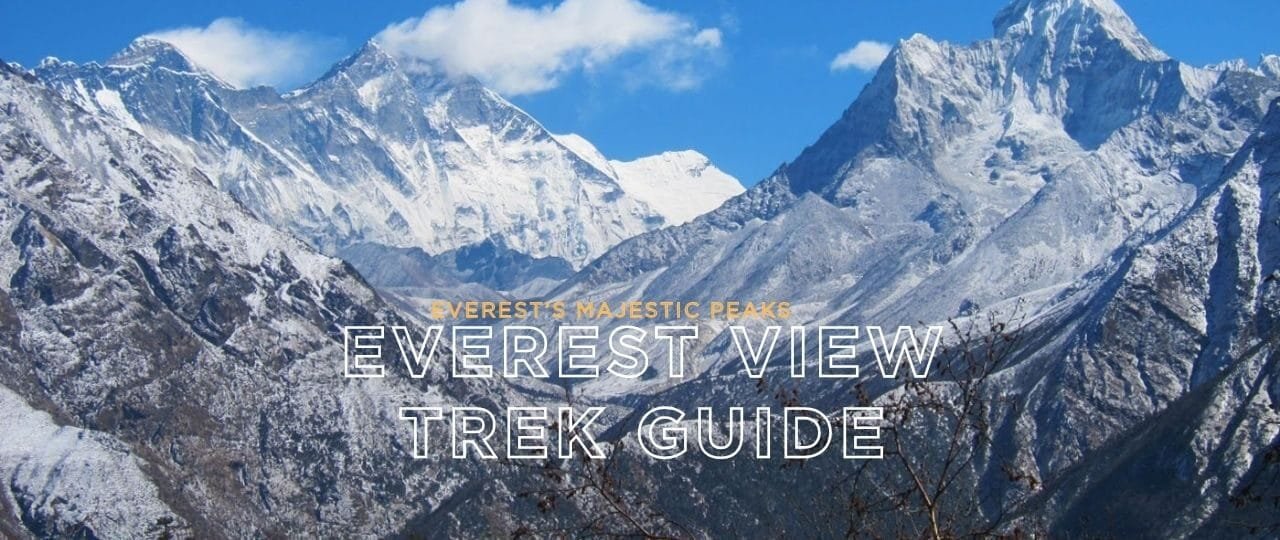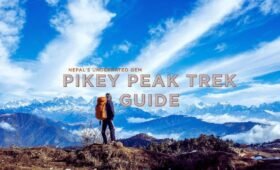The Everest View Trek is an enticing way to witness the world’s highest mountain without committing to a full-blown expedition. Formally known as the Everest Panorama Trek, this short route offers grandiose vistas of Mount Everest, Lhotse, Nuptse, and Ama Dablam, all within a compact timeframe. Many travelers gravitate toward the Everest View Trek for its stunning Himalayan panoramas, friendly Sherpa culture, and moderate altitude, making it more accessible than the entire Everest Base Camp trail.
In this comprehensive Everest View Trek Guide article, we delve into every aspect of the Trek: from the essential Itinerary to cost, difficulty level, best times to visit, route details, and how to merge your trek with philanthropic travel through Volunteers Initiative Nepal (ViN). Whether you’re an experienced hiker wanting a scenic detour or a newcomer seeking a feasible Himalayan challenge, the Everest View Trek provides a captivating taste of Everest’s grandeur in about a week’s journey.
Introduction
1. Introduction: Why the Everest View Trek?
The Everest View Trek is ideal for those who dream of glimpsing the world’s tallest peaks but lack the time or stamina for a two-week trek to Everest Base Camp. By focusing on vantage points around Namche Bazaar and Tengboche, the Everest View Trek (alternatively called Everest Panorama Trek) showcases the region’s mountain highlights and Sherpa culture without exceeding altitudes of around 3,900 meters. This moderate approach significantly reduces the risk of altitude sickness while still delivering remarkable Himalayan vistas.
Statistic: According to Nepal’s Department of Tourism, over 45,000 foreign trekkers visited the broader Everest region last year. However, a notable percentage opt for shorter routes like the Everest View Trek, especially families, seniors, or travelers balancing tight schedules. In just under a week, you can experience airy ridges, ancient monasteries, and welcoming lodges that define the Everest region.
The Everest View Trek was perfect for me. I saw Everest at dawn from the Tengboche ridge, shared tea with Sherpa families, and never felt overwhelmed by extreme altitude
says Samantha, a 42-year-old trekker from Canada who completed it in mid-autumn.
History
2. Cultural and Environmental Backdrop
The region, famously known as Khumbu, exudes an unmatched mountain culture. Sherpas migrated from Tibet centuries ago, weaving Buddhist traditions into their daily lives—visible in mani walls, prayer flags, and revered monasteries. Each village along the Everest View Trek Route resonates with Sherpa customs and hospitality.
Environmentally, the area falls within Sagarmatha National Park, a UNESCO World Heritage Site established in 1976 to preserve its alpine flora, fauna, and dramatic terrain. You may spot Himalayan tahr, musk deer, and countless bird species. Meanwhile, sustainability remains vital as climate shifts influence glacial patterns. Local communities champion responsible tourism, urging trekkers to minimize plastic waste and respect local norms.
Trek Itinerary
3. Highlights of the Everest View Trek Itinerary
A typical Everest View Trek Itinerary spans 5–9 days, depending on side trips and rest days. Below is a common 7-day outline:
Day 1: Fly Kathmandu → Lukla (~2,840m), Trek to Phakding (~2,610m)
Scenic 30-minute mountain flight into Lukla’s short runway.
Gentle 3–4 hour trek through farmland and suspension bridges over the Dudh Koshi River.
Day 2: Phakding → Namche Bazaar (~3,440m)
One of the more demanding days. Cross multiple bridges, pass the Jorsalle checkpoint, then ascend steeply to Namche.
Namche serves as the administrative and cultural hub of the Sherpa homeland.
Day 3: Acclimatization in Namche Bazaar
Short day hike to Syangboche (~3,780m) or the Everest View Hotel to see Everest, Lhotse, and Ama Dablam.
Explore local bakeries, gear shops, or the Sherpa Museum in Namche.
Day 4: Namche → Tengboche (~3,870m)
~4–5 hour trek with mild ups and downs, culminating in a final steep climb to Tengboche Monastery.
Panoramic glimpses of Everest, Nuptse, Lhotse, and Thamserku.
Day 5: Tengboche Exploration & Return
Early sunrise yields magical views of Everest’s summit.
Visit Tengboche Monastery and perhaps witness morning prayers.
Return to Namche or Phungki Thanka (~3–4 hours).
Day 6: Namche → Lukla
A long day retracing steps. Each vantage offers final glimpses of the high peaks.
Day 7: Fly Lukla → Kathmandu
Weather permitting, catch the morning flight. Explore Kathmandu’s cultural wonders or rest.
Everest View Trek Duration can compress to ~5 days if skipping a dedicated acclimatization day or side trip. For families or first-timers, a rest day near Namche ensures safer altitude transitions and time to soak in Sherpa culture.
Trek Cost
4. The Everest View Trek Cost
Everest View Trek Cost is generally lower than an entire Everest Base Camp trek but still includes domestic flights, permits, lodging, and more:
- Flights
- Kathmandu → Lukla round-trip ~USD 180–200 each way for foreigners. Weather-induced delays happen, so plan 1–2 buffer days.
- Permits
- Sagarmatha National Park entry fee ~USD 30.
- Khumbu Pasang Lhamu Rural Municipality fee ~NPR 2,000 (~USD 17–20).
- TIMS card (~USD 10–20) may or may not apply if local regulations shift.
- Food & Accommodation
- Teahouse lodging ~USD 5–10 per night.
- Meals ~USD 20–25 daily. Costs rise with altitude, so budget accordingly.
- Guide & Porter (Optional but beneficial):
- An Everest View Trek Guide typically ~ costs USD 25–30/day, and porters ~USD 15–20/day.
- Misc
- Hot shower fees (~USD 2–5), battery charging (~USD 1–3), Wi-Fi (~USD 2–5).
A 7-day itinerary might cost ~USD 600–900 if done. A more inclusive Everest View Trek Package, covering flights, a guide, lodging, and partial meals, can cost ~USD 1,000–1,400, depending on group size and comfort level.
Trek map
5. Route Visualization: Everest View Trek Map
A thorough Everest View Trek Map generally highlights:
- Lukla (~2,840m): Entry by flight, teahouse-laden.
- Phakding (~2,610m): First overnight, farmland, crossing Dudh Koshi.
- Monjo/Jorsalle (~2,835m): Sagarmatha National Park checkpoint.
- Namche Bazaar (~3,440m) is a major acclimatization hub with shops, cafes, and vantage points (Syangboche, 3,780m).
- Tengboche (~3,870m): Famous monastery perched with direct Everest views.
- Lower Altitude Scenic Spots: Some expansions lead to Khumjung or Thame for lesser-crowded vantage ridges.
Everest View Trek Distance from Lukla to Tengboche and back is roughly 60–65 km round-trip, with daily 5–6 hour hikes. The route’s moderate altitudes top at ~3,870m, though day-hikes around Syangboche can approach ~3,900m or more.
Trek Difficulty
6. Everest View Trek Difficulty & Physical Demands
While less strenuous than a full Everest Base Camp or high pass crossing, the Everest View Trek Difficulty remains moderate. You’ll face:
- Steep Ascents: The final 2–3 hour climb to Namche from Jorsalle is especially tricky. En route to Tengboche, another tricky uphill emerges.
- Altitude: Rushing to the highest sleeping point (~3,870m at Tengboche) can trigger mild altitude symptoms.
- Variable Weather: Lukla flights are prone to cancellation due to wind or clouds, forcing flexible schedules.
Novice trekkers handle the trek well if they pace themselves. Yet, solid fitness remains beneficial—some short uphill training (stair climbing, hill walks) pre-departure helps. A rest day in Namche fosters safe acclimatization.
Weather
7. Key Seasons & Everest View Trek Weather
Everest View Trek Weather changes dramatically with altitude and season:
- Autumn (Sept–Nov)
- Crisp days, ~15–20°C around Lukla, near 0°C at night around Tengboche. Clear vistas of Everest, minimal precipitation. Peak trekking traffic, so teahouses fill quickly.
- Spring (Mar-May)
- Rhododendron blooms color the hills. Daytime is mild, with occasional afternoon thunderstorms—and crisp morning views.
- Winter (Dec–Feb)
- Fewer trekkers, sub-zero nights near Tengboche. Lukla flight cancellations are more common. Suitable for solitude if you can handle cold.
- Monsoon (Jun–Aug)
- Regular rainfall hampers flights and creates muddy trails. Early morning flights might manage fewer weather disruptions, but cloud cover might obscure Everest’s summit.
The Everest View Trek’s Best Time is typically autumn or spring for stable conditions and gorgeous panoramas. Winter offers tranquility but colder nights. Monsoon sees lush farmland but frequent flight woes.
Trek Permits
8. Permits & Paperwork: Everest View Trek Permits
A few essential Everest View Trek Permits:
- Sagarmatha National Park Entry (~USD 30).
- Khumbu Pasang Lhamu Rural Municipality Fee (~NPR 2,000, ~USD 17–20).
- If local regulations shift, the TIMS Card (~USD 10–20) might not always apply, but it’s safer to confirm at Kathmandu agencies or Lukla.
Carry your passport, visa, and ~2 passport photos for permit processing. If you choose an Everest View Trek Package, agencies typically manage these details. Keep your permits safe throughout the trek—local checkpoints may verify them.
Trek Accommodation
9. Accommodation & Hospitality: Everest View Trek Accommodation
Everest View Trek Accommodation revolves around teahouses from Lukla to Tengboche. Keynotes:
- Teahouses
- Typically, modest wooden rooms and shared bathrooms.
- Common dining areas with a stove for warmth.
- Local Meals
- In Namche, you can expect dal bhat (lentil-rice), momos, chow mein, and Western staples like pizza or pasta.
- Costs rise with altitude, so budget accordingly.
- Namche Bazaar
- The region’s hub, with more lodging variety: from standard teahouses to slightly upscale lodges with hot showers and Wi-Fi.
- Tengboche
- Limited teahouses near the monastery. Book or arrive early during peak seasons.
Consider carrying extra layers and a high-quality sleeping bag, especially if trekking in winter or if teahouses run short on blankets.
FAQs
10. Top FAQs About Everest View Trek
Below are the seven queries prospective trekkers frequently ask:
How long is the Everest View Trek Duration?
Typically ~7 days (including arrival/departure). Some compress it to 5 days by skipping specific rest stops.
What is the Everest View Trek Difficulty level?
Moderate. Altitude hovers around ~3,870m at Tengboche. Steep climbs near Namche and Tengboche test your stamina.
How much does the Everest View Trek Cost?
~USD 600–900 for a 7-day trip if going basic teahouse style. An Everest View Trek Package might be ~USD 1,000–1,400, including flights, a guide, and partial meals.
Do I need special Everest View Trek Permits?
Sagarmatha National Park (~USD 30) and Khumbu Pasang Lhamu fee (~USD 17–20). Possibly a TIMS card (~USD 10–20) if required.
When is the best time for the Everest View Trek?
Autumn (Sept–Nov) or spring (March) is suitable for stable weather and clear views. Winter is quieter but cold, and the monsoon causes flight disruptions.
Is an Everest View Trek Guide mandatory?
It’s not legally required, but it’s recommended for cultural insights, altitude pacing, and local knowledge if you’re less experienced.
What is the route’s highest altitude?
Tengboche (~3,870m). A day hike to Syangboche (3,780m) or Everest View Hotel (3,880m) might be slightly higher.
Trek Route
11. Everest View Trek Route & Variations
Everest View Trek Route typically runs:
Kathmandu → Lukla flight → Phakding → Namche Bazaar → Tengboche → and back. Some expansions:
- Khumjung & Khunde: Add cultural side trips to these Sherpa villages near Namche.
- Phortse or Pangboche: Extend an extra day or two, and you’ll find vintage ridges with even more evident Everest glimpses.
- Everest Panorama Trek Variation: Another name for the same route, occasionally skipping Tengboche if time-constrained, focusing mainly on Namche vantage points.
Everest View The total Trek Distance from Lukla to Tengboche and back is ~60–total, with daily 400–600m altitude gains in some segments.
Advice
12. Advice on Everest View Trek Guide & Team
While an Everest View Trek Guide isn’t mandatory, a licensed guide enriches your journey:
- Cultural Narratives: Guides detail Sherpa traditions, local legends, and monastery customs.
- Altitude Monitoring: They track your pace, advise on acclimatization, and help if mild AMS arises.
- Logistics & Navigation: They handle teahouse bookings and manage unexpected weather or schedule changes.
Porters (~USD 15–20/day) lighten your load so you can relish the vistas. Many trekkers find a guide-porter duo that ensures safety, reduces altitude risk, and fosters local economic support.
Extra Tips
13. Extra Tips & Everest View Trek Reviews
13.1 Physical Prep & Gear
- Cardio: 4–6 weeks of running, brisk walking, or cycling.
- Stairs: Weighted step-ups mimic Lukla–Namche climbs.
- Gear: Layer up for evenings with a down jacket, gloves, sturdy boots, and trekking poles.
13.2 Minimizing Environmental Impact
- Carry Refillable Bottles: Use boiled or purified water, avoiding single-use plastic.
- Dispose of Trash: Teahouses handle some waste but carry extra packaging if possible.
- Respect Local Culture: Seek permission before photographing monks or inside monasteries.
13.3 Everest View Trek Reviews
Travelers praise the trek’s convenient altitude, mesmerizing Everest vantage, and warm Sherpa hospitality. Negative points typically revolve around Lukla flight unpredictability or teahouse crowding in peak season. Overall, Everest View Trek Reviews reflect an excellent mix of scenic wonder and cultural engagement for a shorter timeframe.
Conclusion
From the thrill of the Lukla flight to early-morning Everest panoramas at Tengboche, the Everest View Trek compresses the Khumbu region’s magic into a brief yet fulfilling adventure. It’s an outstanding choice for novices, families, or travelers on a limited schedule. The synergy of mild altitudes, grand Himalayan vistas, and Sherpa cultural immersion cements the trek’s position as a top-tier short route in Nepal.
Merge Trekking & Community Empowerment
Volunteers Initiative Nepal (ViN) organizes charity trekking and travel tours, ensuring your Himalayan experience supports grassroots projects. By joining a trek with ViN, all proceeds channel to local empowerment—doubling your impact as you witness Everest’s beauty:
- Share: Inspire friends and families to choose philanthropic travel, ensuring Himalayan communities thrive alongside tourism.
- Volunteer: Spare extra days to teach English in local schools near Lukla or Namche or assist in health awareness sessions.
- Internship: Combine your academic or professional background (such as environmental science or social work) with real-world community needs.
- Donation: Modest financial or material contributions can drive local educational or infrastructural improvements.
By weaving philanthropic synergy into your trek, you transform the Everest View Trek from a mere holiday to a force for positive change. Namaste, and may your footprints in the Khumbu resonate with empathy, forging a sustainable future for Nepal’s mountain communities.
Extended Guidance & Final Encouragement
To finalize your plan for the Everest View Trek, consider these deeper details:
1. Seasonal Nuances
- Autumn: Crisp views, moderate to heavy teahouse traffic. Secure lodging early in Namche or Tengboche.
- Spring: Blooming rhododendrons, calmer trails than autumn. Occasional afternoon clouds.
- Winter: Sub-zero nights above 3,000m, fewer crowds. Lukla’s flights are frequently canceled.
- Monsoon: Lush farmland, daily rains. Lukla flight disruptions and occasional thick clouds block Everest.
2. Potential Minor Expansions
- Khumjung & Khunde: A day-hike from Namche reveals local monasteries, the Hillary School, and more close-range Everest glimpses.
- Phortse: Scenic vantage, spotting Himalayan wildlife (musk deer, Danphe birds). A 1–2 day extension.
3. If Time Allows
Some trekkers spontaneously add a day in Tengboche, witnessing prayer ceremonies or day-hiking to vantage ridges above the monastery. Crisp sunrises often yield unforgettable photography, especially in autumn.
4. Doubling the Impact with ViN
After or before your trek, consider volunteering in rural outposts near the Khumbu area or in Kathmandu’s periphery. This synergy fosters deeper cross-cultural appreciation—enabling you to leave more than footprints behind.
5. Rounding Out Practical Tips
- Flights: Lukla morning flights are typically more reliable. Arrive at Kathmandu domestic airport by 5–6 AM.
- Insurance: Ensure coverage for up to ~4,000m altitude, including helicopter evacuation if weather or injury arises.
- Packing: A 35–45L pack for a 7-day trek is ample if teahouse-based—a robust daypack for water, camera, and layers.
- Prevention: If you sense mild altitude sickness (headache, insomnia), rest an extra day. Hydration is key.
6. Final Affirmation
The Everest View Trek indeed merges shortness and grandeur—offering ephemeral but powerful glimpses of Everest’s summit and the Khumbu’s intangible charm. With a mindful approach and some philanthropic synergy, your trekking story resonates far beyond personal gratification, fostering empowerment for local communities and reinforcing the region’s cultural legacy for generations.




